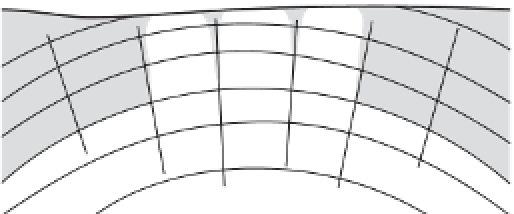Geology Reference
In-Depth Information
envisages a two-stage process of deep weathering and
stripping, similar to the two-stage process envisaged in
the formation of granite boulders. It assumes that the
fracture density of a granite massif has high and low com-
partments. In the first stage, etching acts more readily on
the highly fractured compartment, tending to leave the
less-fractured compartment dry and resistant to erosion.
In the second stage, the grus in the more weathered,
densely fractured compartment is eroded. This theory
appears to apply to the bornhardts in or near the valley
of the Salt River, south of Kellerberrin, Western Australia
(Twidale
et al
. 1999). These bornhardts started as subsur-
face bedrock rises bulging into the base of a Cretaceous
and earlier Mesozoic regolith. They were then exposed
during the Early Cenozoic era as the rejuvenated Salt
River and its tributaries stripped the regolith. If the two-
stage theory of bornhardt formation should be accepted,
then the development of nubbins and koppies from born-
hardts is explained by different patterns of subsurface
weathering. Nubbins form through the decay of the outer
few shells of sheet structures in warm and humid cli-
mates, such as northern Australia (Figure 5.29a). Koppies
probably form by the subsurface weathering of granite
domes whose crests are exposed at the surface as plat-
forms (Figure 5.29b). However, inselbergs and associated
landforms in the central Namib Desert, Namibia, show
()
a
()
b
Time 1
Time 1
Time 2
Time 2
Time 3
Time 4
Time 3
Time 5
Figure 5.29
Formation of (a) nubbins and (b) castle koppies from bornhardts.
Source:
After Twidale and Campbell (1993, 243, 244)

















